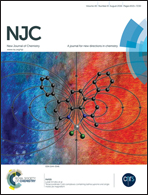Construction of two novel borotungstates modified by different ligands connected with single/double bridges†
Abstract
Two novel organic–inorganic hybrid borotungstates are decorated by two disparate ligands: (H2bibp)2[bibp{Cu(bipy)(bibp)}2{Cu(bipy)Cl}2{BW12O40}2]·3H2O (1) and [{Cu(bipy)2}{Cu(bipy)(Hbtb)}{BW12O40}] (2) (bipy = 2,2′-bipyridine, bibp = 4,4′-bis(imidazolyl)biphenyl, btb = 1,4-bis(1H-1,2,4-triazol-1-yl)benzene) have been hydrothermally synthesized and structurally characterized by elemental analysis, IR, TG, UV-Vis, XRD and single-crystal X-ray diffraction. Compound 1 exhibits an interesting network consisting of two [BW12O40]5− ({BW12}) polyoxoanion units linked by two kinds of copper ions to shape a hole structure. Each unit is linked through [bibp{Cu(bipy)(bibp)}2{Cu(bipy)Cl}2]6+ to form a Z-type one-dimensional (1-D) chain by alternating the single/double-bridge connection. Compound 2 is composed of {BW12} polyoxoanions and the [{Cu(bipy)2}{Cu(bipy)(Hbtb)}]5+ coordination cation, connected by a {Cu-btb-Cu} single-bridge to generate a novel 1-D network. There are π–π stacking interactions or supramolecular interactions all throughout to construct two-dimensional (2-D) and three-dimensional (3-D) architectures. The photocatalytic properties, electrochemical properties and electrocatalytic activities of these two compounds have been investigated in detail.


 Please wait while we load your content...
Please wait while we load your content...